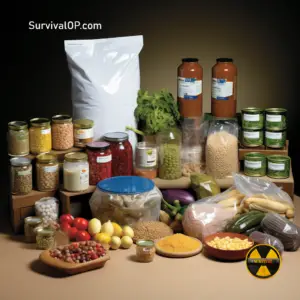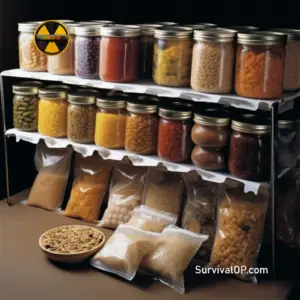Introduction to Emergency food for long-term storage
In today’s unpredictable world, being prepared for unforeseen events is not just wise but essential. Emergency food, specifically designed to be consumed during crises, can make the difference between mere survival and maintaining good health during prolonged periods of disruption.
With everything from natural disasters, such as hurricanes and earthquakes, to economic downturns or supply chain interruptions, the need for reliable food sources becomes paramount. Emergency food for long-term storage ensures that, regardless of what life throws our way, our nutritional needs are met without compromise. This preparation fosters peace of mind, allowing us to focus on other pressing matters during times of crisis.
As we delve deeper into this topic, we’ll explore the different options available, their benefits, and best practices to maximize their shelf life and utility. Whether you’re a seasoned prepper or just beginning to understand the importance of emergency readiness, this guide seeks to provide foundational knowledge of long-term food storage essentials.
Why Long-term Food Storage is Crucial
- The unpredictability of Nature: Natural disasters can strike without warning, causing disruptions in local food supply chains.
- Economic and Political Uncertainties: Events like recessions, inflation, or political instabilities can affect food prices and availability.
- Global Challenges: Global events such as pandemics can halt supply chains, making daily grocery trips a challenge.
- Self-reliance: Having a stash of emergency food reduces dependency on external sources, fostering a sense of independence during crises.
- Reduction of Panic: A dependable food reserve can alleviate stress and panic during emergencies, ensuring calm decision-making.
- Insurance Policy: Think of long-term food storage as an insurance policy for your dietary needs, ensuring you’re nourished regardless of external circumstances.
- Peace of Mind: Knowing there’s a backup can provide significant mental relief, allowing you to focus on other aspects of emergency preparedness.
In an ever-changing global landscape, the possibility of encountering unexpected challenges is not a matter of “if” but “when.” Natural disasters, from hurricanes and wildfires to earthquakes and floods, can strike with little to no warning, leaving communities cut off from regular food supply chains.
Beyond nature’s unpredictabilities, economic downturns or political instabilities can disrupt food availability, leading to shortages or inflated prices. But these crises are just the tip of the iceberg. As we’ve witnessed with global events like pandemics, entire supply chains can be halted, turning what was once a routine grocery trip into a significant challenge. In such scenarios, relying solely on the immediacy of local stores is a gamble.
Long-term food storage acts as an insurance policy, ensuring that even in extended periods of disruption, one’s dietary needs are not jeopardized. Beyond mere sustenance, having a dependable food reserve reduces panic, fosters self-reliance, and provides a sense of security, allowing individuals and families to navigate challenges with a clear mind and a full belly.
Types of Emergency Food Options
When it comes to securing food for prolonged emergencies, variety is not just the spice of life but a lifeline. Different food storage methods cater to diverse needs, ensuring nutrition, longevity, and even ease of preparation. MREs (Meals Ready to Eat), initially designed for military operations, offer complete meals that are quick to prepare, encompassing a balance of proteins, carbohydrates, and essential vitamins.
Their portability and nearly instant preparation make them a favored choice for many preppers. On the other hand, Freeze-dried Foods stand out for their lightweight nature and extended shelf life, with the bonus of retaining most of their original nutritional value and flavor. For those seeking familiar comfort, Canned Foods provides a taste of home. From vegetables and fruits to soups and meats, they offer a wide range of options, though their weight and bulk might be a consideration for some.
Non-perishables, like rice, pasta, and beans, are staples in long-term food storage for their longevity and versatile culinary applications. Finally, for those on the move or who need a quick energy boost, Food Bars – be they energy, protein, or survival bars – offer dense nutrition in a compact form. Each of these options has its unique strengths, and understanding them is the first step in creating a comprehensive emergency food strategy tailored to individual or familial needs.
Factors to Consider When Choosing Foods for Storage

Selecting the right emergency food isn’t just about grabbing any shelf-stable item. It demands careful consideration to ensure not just longevity, but also nutritional sufficiency and practicality during potential crises. One of the most vital considerations is the Nutritional Content of the stored food.
During emergencies, the body may require more energy, making it imperative to have a balanced intake of proteins, fats, carbohydrates, and essential vitamins and minerals. Another crucial aspect is the Shelf Life of the products. While some items might last a few years, others can sustain for decades if stored correctly, ensuring you’re not caught off-guard by expired supplies. Packaging plays a pivotal role in both the longevity and usability of food.
Resealable packaging can help maintain freshness after opening, while vacuum-sealed options can extend the food’s shelf life and protect against external contaminants. With the basics covered, one shouldn’t neglect Taste and Variety. Consuming the same meals repetitively can lead to “palate fatigue,” making it essential to have a diverse food selection to maintain interest and morale. Lastly, considering Special Dietary Needs is fundamental.
Whether someone in the household requires gluten-free options, vegan foods, or any other specific dietary considerations, planning for these ensures everyone’s health and well-being is prioritized during challenging times. Making informed choices based on these factors ensures your emergency food storage is robust, balanced, and tailored to your unique requirements.
Storage Tips and Best Practices

Storing emergency food is more than just setting aside a corner in your basement or pantry. Proper storage is a proactive approach that can vastly extend the shelf life of your supplies and guarantee their quality when you need them most. At the heart of this is Proper Container Selection.
While plastic bins might suffice for some items, others benefit from the airtight and light-blocking properties of mylar bags or the durability of food-grade buckets. The Environment in which you store food plays an equally critical role. A cool, dry place, away from direct sunlight, can prevent the degradation of food products, preserving their nutritional content and taste.
Humidity can be a silent adversary, encouraging mold growth and reducing shelf life; hence, using desiccants or maintaining a moisture-free storage environment becomes paramount. Instituting a Rotation System is also pivotal. Adopting the ‘First In, First Out’ (FIFO) method ensures that older stocks are used first, preventing waste and ensuring continuous replenishment of fresher supplies. But, it’s not just about the food.
Equally vital is considering water storage. Water Purifiers and long-term water storage solutions should accompany your food reserves, as clean water is just as critical, if not more so, during emergencies. Proper labeling, regular checks, and keeping an inventory can also streamline the storage process. When done right, these best practices provide a safety net, ensuring your emergency food remains accessible, fresh, and nutritious, no matter when the need arises.
Potential Pitfalls and How to Avoid Them
Every well-intentioned plan can encounter challenges, and long-term food storage is no exception. Being aware of these potential pitfalls can be half the battle in ensuring your supplies remain effective. A common oversight is the Over-reliance on One Food Type.
While it might be tempting to stock up exclusively on a favorite item or a great deal, a lack of variety can lead to nutritional deficiency and palate fatigue. Diversifying your food storage ensures a balanced diet and maintains interest in meals, even in prolonged emergency situations. Another critical mistake is Ignoring Water Storage.
Food might sustain us, but water is absolutely vital for survival. For every food storage plan, there should be an equal, if not more robust, strategy for clean water access. This includes storage solutions and purification methods to ensure safe consumption. Improper Storage Conditions, such as exposing food to direct sunlight, dampness, or pests, can drastically reduce shelf life and compromise food quality.
Regularly inspecting storage areas, ensuring proper sealing, and keeping food elevated from direct ground contact can mitigate many of these risks. Lastly, failing to Rotate Supplies can lead to expired items, making your storage less effective when you need it most.
By maintaining an updated inventory and practicing the FIFO method, you can ensure the freshness and viability of your food stocks. In the realm of emergency preparedness, foreknowledge of these pitfalls and proactive measures to counteract them can mean the difference between a resilient food reserve and an ineffective one.
You may be interested in, Preparing your home for a long-term power outage
Conclusion
The journey through understanding the intricacies of emergency food for long-term storage reveals a narrative that extends beyond mere sustenance. It’s a tale of foresight, responsibility, and a commitment to the well-being of oneself and loved ones in times of unforeseen challenges.
By harnessing the power of diverse food options, understanding the nuances of storage, and avoiding common pitfalls, we not only ensure our dietary needs are met during crises but also anchor our resilience in a foundation of preparation. This proactive approach transcends the realm of food, fostering a mindset of readiness that empowers individuals to face the unpredictable head-on.
In a world where certainty can sometimes be a luxury, the assurance provided by a well-curated emergency food supply becomes a beacon of hope, a testament to human adaptability, and a call to action for all to prioritize preparedness.
As you embark or continue on this journey of preparation, let the insights gained here serve as a guiding compass, steering you towards a future where come what may, you stand ready.

